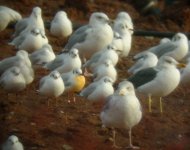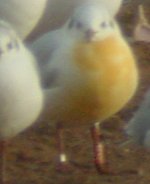Adey Baker
Member
It's always worth checking through flocks of gulls for anything interesting and this morning Carl Baggott and I found this bright orange Black-headed Gull in the middle of a couple of hundred other gulls at Huncote, Leics on a 'capped' rubbish tip.
Despite the fact that the larger leg-tag is numbered it's not easy to read - a plea to all ringers in these situations: Please use high-contrast colouring, i.e. black on white!
Carl has got a sharper image than mine on the leg and may be able to read the number by using the contrast tools in PS - if so we'll be able to trace where it was grabbed and 'painted!'
Despite the fact that the larger leg-tag is numbered it's not easy to read - a plea to all ringers in these situations: Please use high-contrast colouring, i.e. black on white!
Carl has got a sharper image than mine on the leg and may be able to read the number by using the contrast tools in PS - if so we'll be able to trace where it was grabbed and 'painted!'






